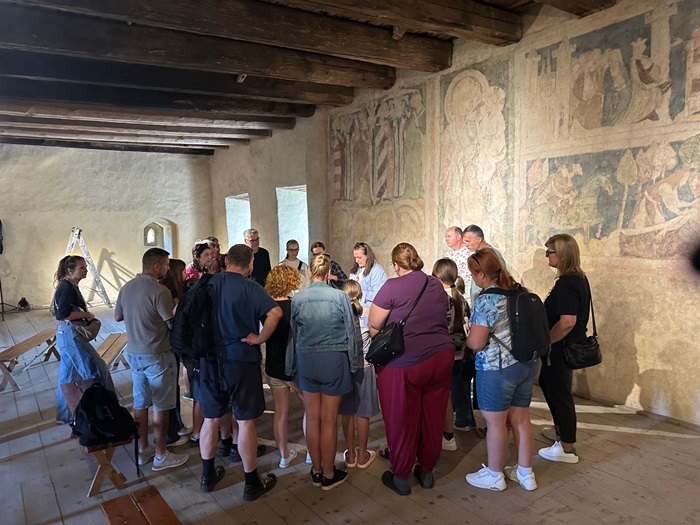Archaeologists from the Jagiellonian University are examining unique paintings in Siedlęcin.

Researchers from the Jagiellonian University's Institute of Archaeology are conducting research and documentation on the medieval princely tower in Siedlęcin, Lower Silesia, including unique wall paintings depicting the legend of Lancelot of the Lake. The scientists also determined the seasons when trees were felled for the tower's construction 700 years ago.
The 14th-century residential tower in Siedlęcin – considered a valuable monument of medieval secular architecture and one of the most valuable monuments in Lower Silesia – is also one of the best-preserved structures of its kind in Poland. It owes its fame, among other things, to the oldest wooden ceilings in Poland and the world's only medieval paintings preserved in their place of origin, depicting episodes from the legend of Sir Lancelot of the Lake.
Research and documentation of the tower is being conducted by the research team of Professor Radosław Palonka of the Jagiellonian University as part of the "Academic and Digital Approaches to Cultural Heritage Preservation" project, carried out in cooperation with the "Prince's Tower in Siedlęcin" Association. The aim of the work is to thoroughly document the paintings and precisely inventory the tower's architecture.

"All of this is done to document the current state of preservation of the paintings and the tower, but also through analyses using specialized software to attempt to visualize and make more legible individual fragments of the paintings, often invisible to the naked eye today and impossible to capture even with advanced digital photography," said Dr. Radosław Palonka, quoted in the university's press release. "I was very keen to show the importance and splendor of this monument to a wider audience, as well as to highlight the Jagiellonian University's involvement in the research of such an important and valuable object," the scientist noted.
One of the intended outcomes of the digitization is a three-dimensional model of the tower in Siedlęcin, containing historical information in separate layers. In addition to showing the current state of preservation of the structure, it will also include reconstructions of the various phases of its construction. According to the Jagiellonian University announcement, digital reconstruction of the tower's no longer extant elements, whose existence can be inferred from archival materials or documented traces, is also planned.
The ongoing work is a continuation of research conducted at the Jagiellonian University in Siedlęcin since 2008 by a team led by Dr. Przemysław Nocuń from the Institute of Archaeology of the Jagiellonian University. The university noted that the researchers managed to locate, among other things, fragments of the protective perimeter that once surrounded the tower, the remains of a stone bridge, and previously unknown sections of the moat. Archaeologists examined the building in front of the tower, which included a 15th-century gate tower, a brick manor house from the turn of the 15th and 16th centuries, and a kitchen block approximately a century later. The team also examined the ceilings inside the tower.

"Their dendrochronological research provided us with a wealth of interesting information. We learned not only the specific years, but even the seasons, in which the trees used in the tower's construction were felled. The timber used to build the ceiling above the ground floor was felled in the spring and summer of 1313, the first floor at the turn of 1313 and 1314, the second floor in the spring of 1314, and the third floor already at the turn of 1314 and 1315. It's also phenomenal that in the filling of one of the ceilings we found cut and reused ladders and scaffolding elements, which in turn were cut down at the end of 1312 and in 1313. There is no other structure in Europe where the dynamics of the construction process have been so well understood," noted Dr. Przemysław Nocuń, quoted by the university.
The 14th-century residential tower in Siedlęcin was built of stone on a roughly rectangular plan, and is believed to have been founded by Henry I, Duke of Jawor. It served as a residential residence, but also had defensive features. It had six stories – basements, ground floor, three residential floors, and a battlemented walkway. It was surrounded by a defensive wall and a moat.
The building's greatest attraction is the polychrome paintings from 1320-1330, created by artists from the Swiss-German border. The central composition is a depiction of St. Christopher carrying Christ. Next to them are the world's only medieval paintings preserved in situ, i.e., where they were created, depicting episodes from the life of Sir Lancelot of the Lake, one of the legendary knights of the Round Table. (PAP)
yucca/ agt/
The PAP Foundation permits free reprinting of articles from the Nauka w Polsce website, provided that you notify us by email once a month of your use of the website and cite the source of the article. On portals and websites, please include the linked address: Source: naukawpolsce.pl, and in journals, please include the annotation: Source: Nauka w Polsce website - naukawpolsce.pl. This permission does not apply to information in the "World" category or any photographs or video materials.
naukawpolsce.pl





